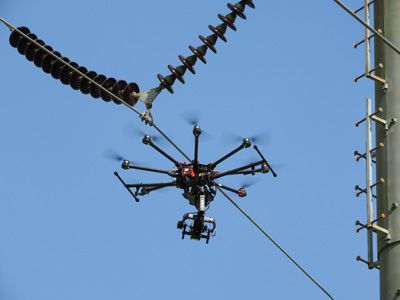
The Latest Developments in Drones for the North American Utility Sector
Although drone sales in the North American utility market will reach only about $850,000 in 2018, that number is expected to grow by more than 20 times – to $25 million – by 2026, as U.S. regulations ease and drone technology improves.
That’s the outlook from Michael Hartnack, a research analyst covering drones and robotics for transmission and distribution operations worldwide for Navigant Research. (For Navigant’s full market report, visit www.navigantresearch.com/research/drones-and-robotics-for-transmission-and-distribution-operations.)
While those numbers might appear underwhelming, they represent hardware sales only, and not revenue from ancillary drone services – such as piloting, training, software development, data management, cybersecurity and other support offerings – which will make the overall U.S. utility drone market significantly larger, Hartnack said.
So, what exactly is the state of drones in the North American utility sector today? What pieces need to fall into place to accelerate growth? And what are some of the most interesting future possibilities?
UFP recently spoke with Hartnack to get his perspective. Here is an edited version of our conversation.
UFP: With all the buzz surrounding the potential for drones in utility applications, the market size you’re quoting is much smaller than one might expect. Why is that?
Michael Hartnack: Right now, there aren’t many utilities that own drones. And the ones that do may buy three, 10, 15 or, at most, 20 units. So, when you consider that the price of a drone is anywhere from $8,000 to $50,000, that doesn’t equate to a tremendous dollar amount for the overall market.
Today, the utilities that are using drones are doing so as part of a limited pilot program – and that’s where things are going to stay until regulations are eased. So, there’s a ton of potential for drones, but everything is kind of stalled right now.
That’s why, in our research, you see an exponential growth curve. There’s minimal growth until the middle of the forecast. And then the market takes off.
What assumptions are you making to explain such a steep growth curve?
One assumption is that the FAA will ease regulations, specifically the rule that requires the drone to always be in the line of sight of the operator. This would enable utilities to inspect much longer segments of power lines per flight, making drones more efficient, productive and practical.
So far, Xcel Energy [based in Minneapolis] is the only utility company that has been granted an exception by the FAA to fly drones beyond the operator’s line of sight.
So, is your assumption that the FAA will ease line-of-sight restrictions across the board for utilities?
Yes. It’s hard for me to put a precise timeline on it, but for most people I have spoken to in the industry, one to three years is about when they expect the FAA to start granting more exceptions like they have done for Xcel Energy on a much bigger scale.
Beyond regulations, what’s holding back wider-spread adoption of drones by utilities?
Once you take the regulations out of it, you still have a technology barrier. For the most part, the technology required to do a lot of the work utilities want them to do is already here. For example, the ability to put a camera on a drone and fly it over and inspect transmission lines – that’s here.
The issue now becomes, how far can the drone fly without having to be recharged? How can it be controlled without somebody piloting near it?
There are a lot of technological questions that need to be answered, but none of those questions is really being addressed right now because of the line-of-sight issue.
As this market grows, will you see utilities own their drones or outsource that function of their operations?
Right now, utilities, for the most part, own their drones. But I think there will be a shift toward a more hybrid approach where utilities may own the drone itself but outsource other aspects of drone operations. They’ll say, “OK, I’m going to own the drone, but I want to use your pilots and software platform where all I need to do is plug into an app and see the data.”
What are some exciting possibilities for drones that could create game-changing breakthroughs for utility operations?
One possibility is being able to install a drone in a box under a transmission line or a substation, and program it along the lines of, “OK, once a month, I want this drone to fly over a preset area of this transmission line.” And it would have a long enough battery life to do the job. Or, in some cases, the drones could return to home base and get a new battery all by themselves, and then get back to work, flying over the line, doing this whole thing autonomously. The end game here is total autonomy; you’re removing the human, as much as possible, from having to be involved with the process.
Another cool application is using drones for light repairs on transmission lines. Right now, if you have a fault that’s caused by a tree branch, you have to roll a truck out there, get everyone all geared up in their safety equipment, cut the power and perform the repair.
But what if you could sit there in the truck and send a drone up with two little robotic arms that grab the tree branch and throw it to the side? And maybe it can do some minor line repair with tape and insulators and things like that. You can save a lot of money and time, minimize power disruption to customers and, most importantly, improve worker safety.
You talk to any utility and the first thing they’ll say is, “Well, this needs to be safe.” Putting a drone up there in these situations is safer than putting a person up there.


